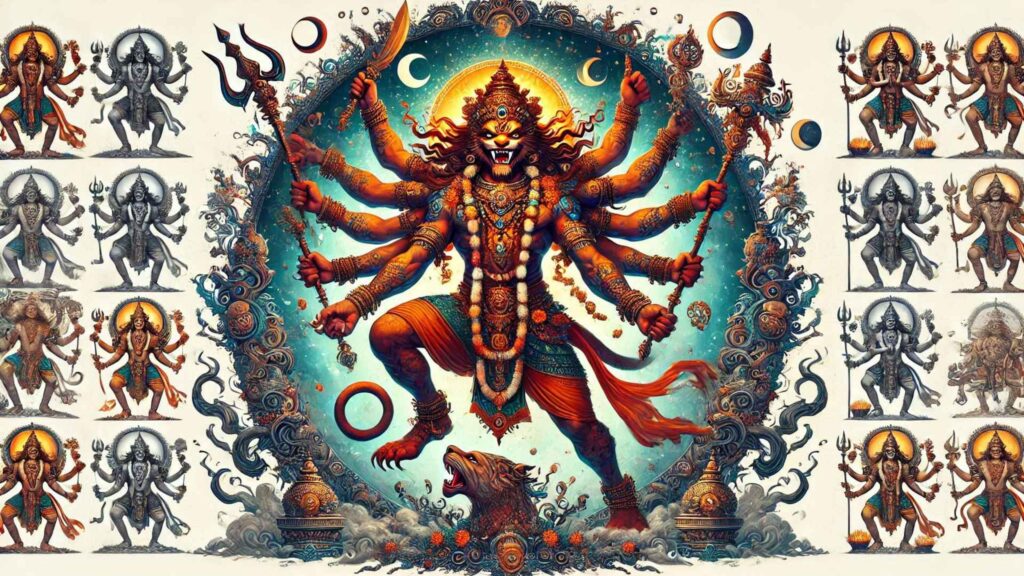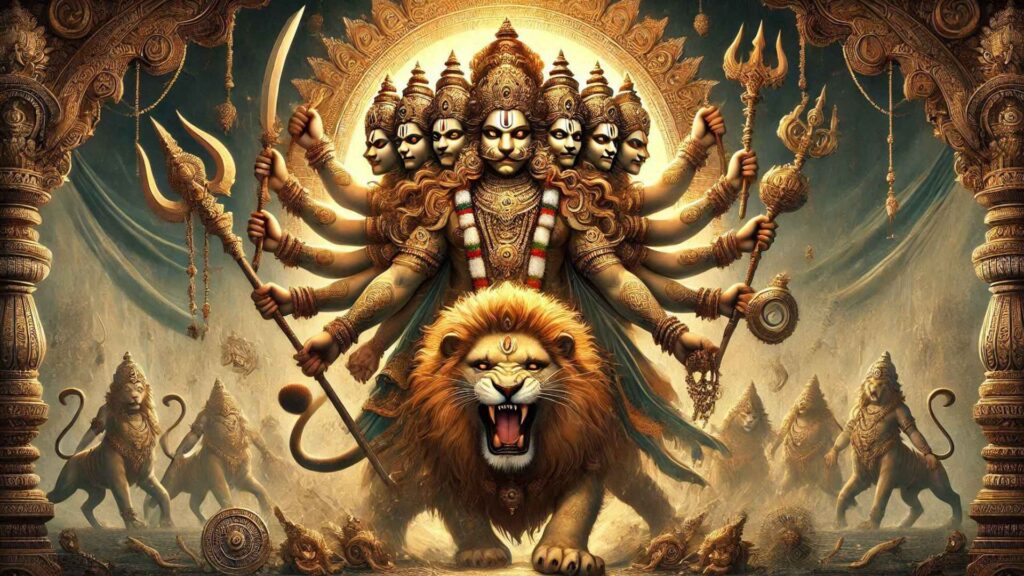Introduction
Bhairava, a powerful manifestation of Lord Shiva, embodies the fierce and protective aspects of divinity. Known as the “Lord of Time” (Kala Bhairava) and the guardian of Dharma, Bhairava is worshipped for his ability to destroy evil, remove fear, and guide devotees on the spiritual path.
Read More About Deities And Gods
Bhairava holds immense significance in Hinduism, particularly within the Shaivite and Tantric traditions. His worship emphasizes the acceptance of both creation and destruction as integral aspects of existence, guiding devotees toward liberation (moksha).
Names and Etymology

Meaning of the Name Bhairava
The name Bhairava is derived from the Sanskrit root words:
- Bhai: Fear.
- Rava: To roar or cry out.
Thus, Bhairava translates to “the one who removes fear through his roar.”
Other Names of Bhairava
- Kala Bhairava – The Lord of Time.
- Swarnakarshana Bhairava – The bringer of wealth and prosperity.
- Asitanga Bhairava – The dark-limbed protector.
- Ruru Bhairava – The compassionate teacher.
- Unmatta Bhairava – The one who transcends societal norms.
Each name highlights a unique aspect of Bhairava’s personality, from his role as a protector to his ability to bring enlightenment.
Symbolism and Iconography

Physical Description
Bhairava is typically depicted with a fierce expression, holding weapons like a trident (trishula), drum (damaru), and a noose (pasha). His hair is often matted, and he is adorned with garlands of skulls.
Symbolism
- Weapons: Represent destruction of ego and protection of Dharma.
- Garland of Skulls: Symbolizes the transience of life and ultimate truth of death.
- Dog as Vahana (Vehicle): Signifies loyalty and the ability to navigate darkness.
- Terrifying Expression: Reflects his role as the destroyer of fear and ignorance.
Flower and Colors Associated
- Flowers: Red hibiscus and Datura are commonly offered.
- Colors: Black and red, symbolizing power, destruction, and transformation.
Mythology and Stories

Birth Story
According to the Shiva Purana, Bhairava emerged from Shiva’s third eye when Brahma’s arrogance reached its peak. To humble Brahma, Bhairava severed one of Brahma’s five heads, symbolizing the destruction of ego and ignorance.
Role in Hindu Mythology
- Protector of Kashi (Varanasi): Bhairava is regarded as the guardian of the holy city of Kashi, ensuring its sanctity and protecting devotees.
- Tantric Practices: Bhairava plays a significant role in Tantric traditions, representing the raw, unrestrained energy of Shiva.
Connection with Other Deities
- Shiva: Bhairava is considered an extension of Shiva’s fierce energy.
- Kali: Bhairava is often paired with Goddess Kali, representing the union of time and energy.
Famous Blessings and Boons
- Removal of fear and ignorance.
- Protection from evil forces.
- Guidance on the path to spiritual liberation.
Spiritual Significance

A Visible Form of God
Bhairava serves as a tangible reminder of the destructive and protective aspects of divinity, teaching devotees to embrace transformation and let go of fear.
Representation of Knowledge and Enlightenment
His fierce demeanor symbolizes the destruction of ignorance, paving the way for spiritual awakening.
Connection to Spiritual Awakening
Bhairava’s energy inspires devotees to transcend societal norms, confront inner fears, and achieve self-realization.
Role in Yoga and Meditation Practices
Bhairava is associated with Kundalini energy, guiding practitioners through the transformative process of awakening.
The Mantra Connection
Chanting Bhairava’s mantra invokes his blessings:
“Om Hrim Batukaya Apaduddharanaya Kuru Kuru Batukaya Hrim Om Phat”
Worship and Rituals
Benefits
- Overcoming obstacles and fears.
- Protection from negative energies.
- Strengthening willpower and focus.
Daily Worship Practices
Devotees light oil lamps, offer red flowers, and chant Bhairava’s mantras during sunrise and sunset. Feeding dogs, considered sacred to Bhairava, is a common practice.
Best Times for Worship
- Ashtami Tithi (Eighth Lunar Day): Considered auspicious for Bhairava worship.
- Significant Days: Bhairava Ashtami, celebrated in November or December.
Important Festivals
- Bhairava Jayanti: Commemorates Bhairava’s manifestation to uphold Dharma.
- Kalabhairava Ashtami: Devotees fast and offer prayers for protection and spiritual growth.
List of Famous Temples
- Kala Bhairava Temple, Varanasi: The most revered temple dedicated to Bhairava, located in the holy city of Kashi.
- Bhairava Temple, Ujjain: Known for its unique rituals involving alcohol offerings.
- Ashta Bhairava Temples, Tamil Nadu: Represent the eight forms of Bhairava.
Modern Relevance
Scientific Understanding
Bhairava’s symbolism of destruction aligns with psychological concepts of confronting fears and breaking attachments.
Environmental Consciousness
As a guardian deity, Bhairava emphasizes harmony with nature and the importance of preserving sacred spaces.
Health Benefits
Meditating on Bhairava reduces stress, instills courage, and enhances focus and determination.
Energy Connection
Bhairava’s energy promotes transformation, helping individuals navigate challenges and embrace change.
Sustainable Living Practices
Bhairava’s teachings inspire mindfulness in consumption and respect for nature’s cycles.
Cultural Impact
Influence on Indian Art and Architecture
Bhairava’s fierce form has inspired intricate temple carvings, paintings, and sculptures, showcasing his role as a cosmic protector.
Presence in Literature and Poetry
Hymns and stotras praise Bhairava’s role as the remover of fear and protector of Dharma.
Impact on Daily Customs
Feeding stray dogs, a practice associated with Bhairava, reflects his compassionate yet fierce energy.
Regional Variations in Worship
- North India: Worship focuses on Bhairava’s role as a protector of Kashi.
- South India: Emphasizes his eight forms (Ashta Bhairava), each representing a cosmic force.
Practical Applications
Morning Prayers and Rituals
Starting the day by chanting Bhairava’s mantra helps cultivate courage and focus.
Benefits of Salutation
Saluting Bhairava invokes protection and the strength to overcome challenges.
Dietary Recommendations
Observing fasting rituals during Bhairava Ashtami fosters discipline and clarity.
Astrological Significance
Bhairava is associated with Saturn (Shani), representing discipline and karmic balance.
Gemstones and Metals Associated
- Gemstone: Black onyx, symbolizing protection and grounding.
- Metal: Iron, representing strength and resilience.
Conclusion
Bhairava, the fierce form of Shiva, embodies the dual aspects of destruction and protection, teaching devotees to confront fears and embrace transformation. His worship emphasizes the acceptance of life’s impermanence and the pursuit of spiritual liberation.
By aligning with Bhairava’s energy, devotees can overcome obstacles, find inner strength, and achieve harmony with the cosmic order.


